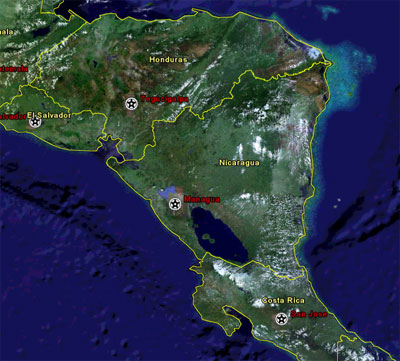NICARAGUA
Please note, this page is not longer being updated. For more recent information, please see news.mongabay.com and use the search function to find the country feed. For more up-to-date data on forest cover and loss, check out Global Forest Watch.
| Nicaragua Forest Figures
Forest Cover Total forest area: 5,189,000 ha % of land area: 42.7% Primary forest cover: 1,849,000 ha % of land area: 15.2% % total forest area: 35.6% Deforestation Rates, 2000-2005 Annual change in forest cover: -70,000 ha Annual deforestation rate: -1.3% Change in defor. rate since '90s: -17.3% Total forest loss since 1990: -1,349,000 ha Total forest loss since 1990:-20.6% Primary or "Old-growth" forests Annual loss of primary forests: n/a Annual deforestation rate: n/a Change in deforestation rate since '90s: n/a Primary forest loss since 1990: n/a Primary forest loss since 1990:0.0% Forest Classification Public: n/a Private: n/a Other: n/a Use Production: n/a Protection: n/a Conservation: 35.6% Social services: n/a Multiple purpose: 64.4% None or unknown: n/a Forest Area Breakdown Total area: 5,189,000 ha Primary: 1,849,000 ha Modified natural: 3,289,000 ha Semi-natural: n/a Production plantation: 51,000 ha Production plantation: n/a Plantations Plantations, 2005: 51,000 ha % of total forest cover: 1% Annual change rate (00-05): 1,000,000 ha Carbon storage Above-ground biomass: 1,154 M t Below-ground biomass: 278 M t Area annually affected by Fire: n/a Insects: n/a Diseases: 33,000 ha Number of tree species in IUCN red list Number of native tree species: 1,000 Critically endangered: 3 Endangered: 16 Vulnerable: 20 Wood removal 2005 Industrial roundwood: 106,000 m3 o.b. Wood fuel: 1,740,000 m3 o.b. Value of forest products, 2005 Industrial roundwood: $8,480,000 Wood fuel: $34,800,000 Non-wood forest products (NWFPs): n/a Total Value: $43,280,000 More forest statistics for Nicaragua |
In the mid- to late 1990s, the government granted a number of logging concessions that significantly increased forest degradation. By 1998 the loss of forest was substantial enough for Nicaragua's president to issue a decree banning the logging of cedar, mahogany, and bombox trees for a five-year period. The decree canceled existing logging permits for these timber species. Nevertheless, Nicaragua's forests continue to suffer from illegal logging operations. Today, by one estimate, illegal logging constitutes about half of total timber production. The trade feeds corruption and has known links to criminal syndicates and gangs.
A second threat to Nicaragua's rainforests is mining. The use of open-pit mines in the San Juan rivershed is of particular concern to environmentalists.
Deforestation was cited as a contributing factor to the widespread damage caused by Hurricane Mitch in 1998. Aerial surveys conducted after the storm indicated that landslides occurred more frequently on hillsides that had been cleared of their vegetation for agriculture and human settlements. Naturally vegetated hillsides were found to suffer fewer mudslides.
Nicaragua's government has encouraged the development of forest plantations, which have expanded from 4,000 hectares in 1990 to more than 50,000 hectares by 2005. About 6 percent of the country is under some form of protection.
Recent articles | Nicaragua news updates | XML
Suggested reading - Books
- Moon Handbooks Nicaragua
- Nicaragua
- Footprint Nicaragua
- Nicaragua Map
- The Naturalist in Nicaragua
- A Field Guide to the Mammals of Central America and Southeast Mexico
Unless otherwise specified, this article was written by Rhett A. Butler [Bibliographic citation for this page]
Other resources
Contact me if you have suggestions on other rainforest-related environmental sites and resources for this country.

Image copyright Google Earth, MDA EarthSet, DigitalGlobe 2005
CIA-World Factbook Profile
FAO-Forestry Profile
Last updated: 6 Feb 2006
